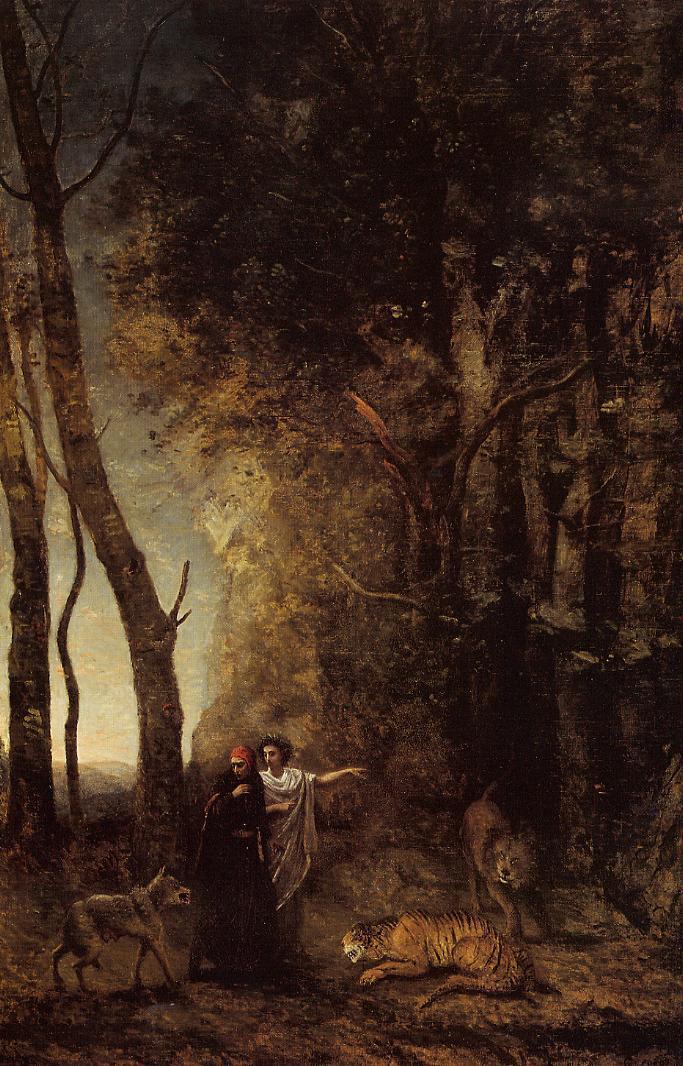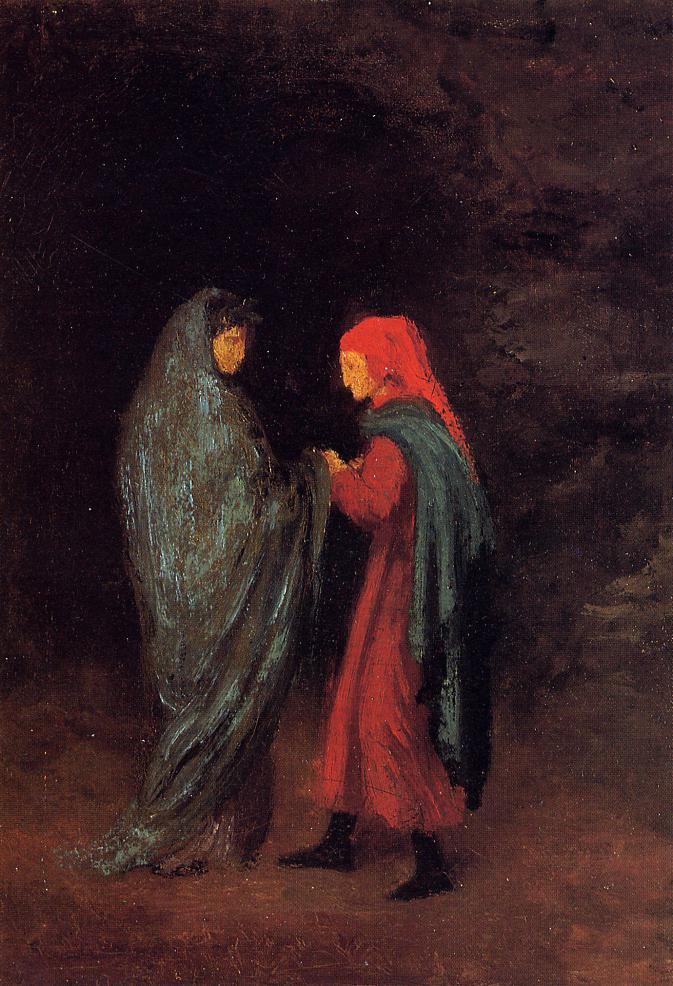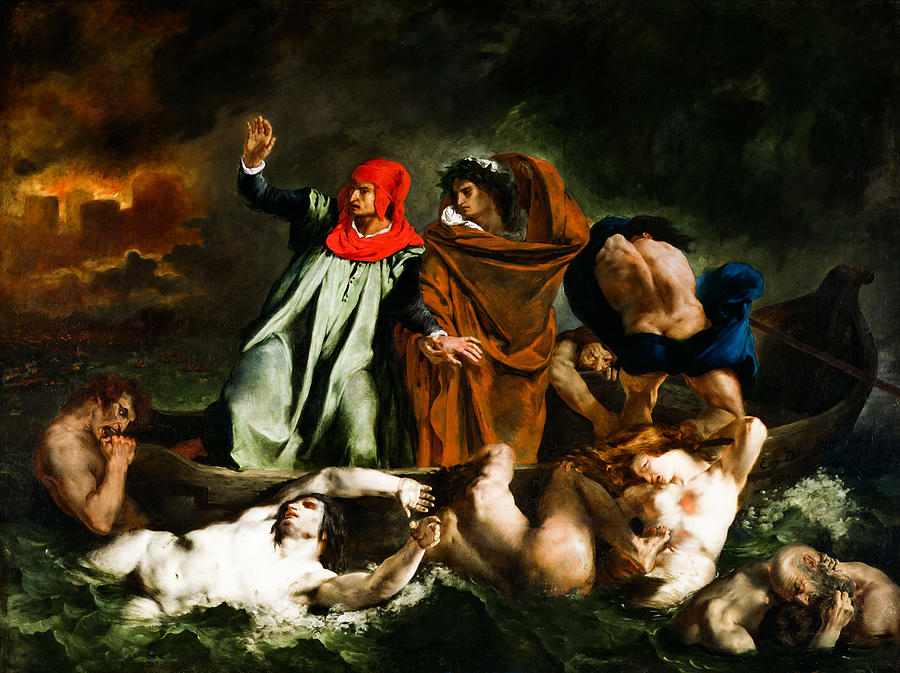
Dante and Virgil, 1859 Camille Corot
Dante and Virgil Dante and Virgil beset by demons, passing through Hell, illustration by Gustave Doré for an 1861 edition of Dante's Inferno (The Divine Comedy). (more)

Dante and Virgil in the Ninth Circle of Hell (Inferno, Canto XXXIV) Dante Alighieri, Divina
Dante is guided by the Roman poet Virgil, who represents the epitome of human knowledge, from the dark wood through the descending circles of the pit of Hell (Inferno). Passing Lucifer at the pit's bottom, at the dead centre of the world, Dante and Virgil emerge on the beach of the island mountain of Purgatory.

Dante and Virgil in the Ninth Circle of Hell, Gustav Doré, oil on canvas, 1861 r/Art
Within the Inferno the relationship between Dante and Virgil is an important one. As mentioned, Dante uses their relationship to contrast the good with the bad, between what is ideal and what was rejected in earthly life therefore meriting for the soul their predicaments in Hell. Hell is a loveless and truthless place.

Dante vs Virgil Artwork by HDSilver on DeviantArt
Dante's 'Inferno' is a journey to hell and back. Written more than 700 years ago, this terrifying epic poem is filled with damned souls, including Cleopatra, Judas Iscariot, and Dante's own enemies.

Dante and Virgil at the Entrance to Hell, 1857 1858 Edgar Degas
Virgil The only character besides Dante to appear all the way through Inferno, Virgil's ghost is generally taken by critics to represent human reason, which guides and protects the individual (represented by Dante/Everyman) through the world of sin. As befits a character who symbolizes reason, Virgil proves sober, measured, resolute, and wise.

Dante and Virgil looking into the inferno, 1863 Stock Image C045/4482 Science Photo Library
Dante and Virgile William-Adolphe Bouguereau 1850. Musée d'Orsay, Paris Paris, France. where Dante, accompanied by Virgil, watches a fight between two damned souls: Capocchio, a heretic and alchemist is attacked and bitten on the neck by Gianni Schicchi who had usurped the identity of a dead man in order to fraudulently claim his.

Pin on Dante's Inferno Painting Series
The Divine Comedy ( Italian: Divina Commedia [diˈviːna komˈmɛːdja]) is an Italian narrative poem by Dante Alighieri, begun c. 1308 and completed around 1321, shortly before the author's death. It is widely considered the pre-eminent work in Italian literature [1] and one of the greatest works of Western literature. [2]

“Dante and Virgil” by Baron Henri de Triqueti (180374)
Over 27,000 video lessons and other resources, you're guaranteed to find what you need. Learn faster. Stay motivated. Study smarter.

"Canto 4 Dante and Virgil Visit the Great Poets of Antiquity" Eric Armusik Artwork on USEUM
Inferno ( Italian: [iɱˈfɛrno]; Italian for "Hell") is the first part of Italian writer Dante Alighieri 's 14th-century epic poem Divine Comedy. It is followed by Purgatorio and Paradiso. The Inferno describes Dante's journey through Hell, guided by the ancient Roman poet Virgil.

Dante and Virgil in the Second Circle in Hell Painting Joseph Anton Koch Oil Paintings
Summary: Canto II Dante invokes the Muses, the ancient goddesses of art and poetry, and asks them to help him tell of his experiences. Dante relates that as he and Virgil approach the mouth of Hell, his mind turns to the journey ahead and again he feels the grip of dread.

“Dante and Virgil in Vallombrosa” by James Smetham, 182189
Dante and Virgil advance toward the giant, mist-shrouded shape. As they approach through the fog, they behold its true form. The sight unnerves Dante to such an extent that he knows not whether he is alive or dead. The figure is Lucifer, Dis, Satan —no one name does justice to his terrible nature.

Dante and Virgil Painting by Raphael Fine Art America
Author Taylor Mendelsohn View bio Instructor Summer Stewart View bio Explore the "Inferno" in the epic poem "Divine Comedy" with Dante and Virgil. Read about important Virgil quotes and why.

Dante and Virgil to Hell Painting by Hippolyte Flandrin Pixels
Free Shipping Available. Buy on eBay. Money Back Guarantee!

Dante and Virgil in Hell by Eugene Delacroix Painting by Orca Art Gallery Fine Art America
Are Dante and Virgil Real People? Yes, both Dante and Virgil were real people. Here's where it gets confusing, though: Dante and Virgil lived in different historical eras. They never met in real life. Dante, the author of the Divine Comedy, included himself and Virgil as characters in his epic poem.

Dante and Virgil a photo on Flickriver
Dante narrates The Divine Comedy in the first person as his own journey to Hell and Purgatory by way of his guide Virgil, the poet of Roman antiquity who wrote the Aeneid, and then to Heaven,.

Dante and Virgil in Hell by Delacroix (Illustration) World History Encyclopedia
Dante and Virgil in Hell is an 1850 oil-on-canvas painting by the French academic painter William-Adolphe Bouguereau. It is in the Musée d'Orsay in Paris. [1] The painting depicts a scene from Dante's Divine Comedy, which narrates a journey through Hell by Dante and his guide Virgil.